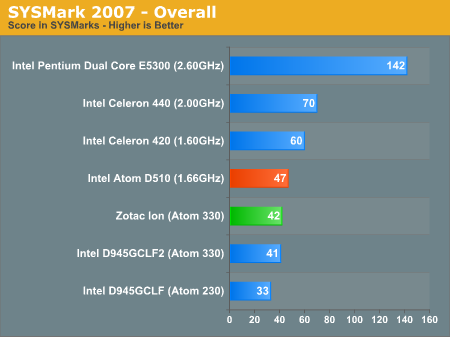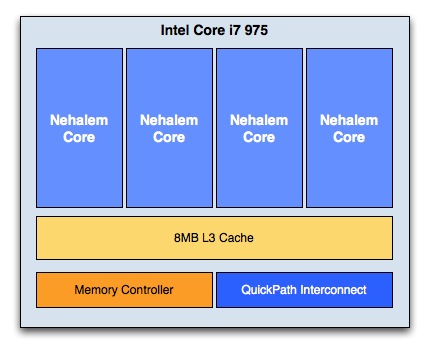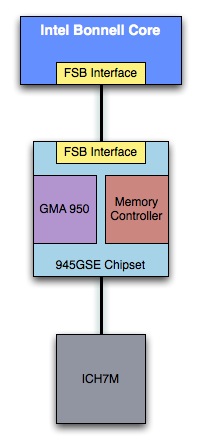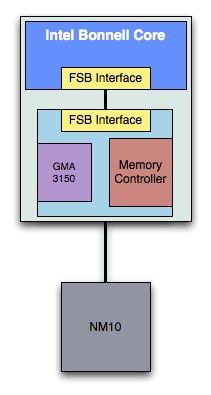Why Pine Trail Isn't Much Faster Than the First Atom
by Anand Lal Shimpi on January 27, 2010 12:48 PM EST- Posted in
- CPUs
In 2008 Intel introduced the Diamondville platform. This was the Atom platform that was used in the vast majority of netbooks and nettops. You had an Atom processor (codename: Diamondville) and Intel's 945GSE chipset. The memory controller was located on the chipset which was built on a 90nm process that ended up eating quite a bit of power.

Dual-core Atom "Diamondville" (left) vs. Dual-core Atom "Pineview" (right)
At the end of last year, Intel brought forth Pine Trail. Pine Trail used a new version of the Atom processor (codename: Pineview) and Intel's NM10 Express chipset. The memory controller was moved off the external chipset and on-die with the Atom processor. Graphics also made their way on die and the resulting 45nm chip consumed far less power than the old Atom + 945GSE combo.
When AMD integrated a DDR memory controller with the K8, we saw a big drop in memory latency and tremendous boost in performance. When Intel did the same with Nehalem the results were similar. Yet when we reviewed Pine Trail we saw virtually no drop in memory latency and very few situations where performance actually improved. In fact, it was only on the dual-core desktop Pine Trail system we reviewed that we saw any tangible performance gains.

Remember that Intel's Atom processor uses a dual-issue in-order architecture. As such you'd expect a huge boost from Intel integrating its DDR2 memory controller. After a bit of digging, we've finally figured out why that wasn't the case.
Unlike Nehalem, when Intel integrated the memory controller in Pineview it didn’t start with a brand new design. Here’s what Nehalem looks like from a high level:

The memory controller is on die and connects directly to the cache subsystem via some very low latency interconnects.
And here’s what Diamondville and Pine Trail look like:
Intel Atom "Diamondville" Platform 2008 | Intel Atom "Pine Trail" Platform 2009-2010 |
 |  |
Notice anything funny? There’s still a FSB interface between the CPU core and the memory controller. It’s all on die, but the Pineview CPU core still needs to go through the FSB unit before it can touch the IMC. That’s why the latency didn’t improve much, if at all. There are some improvements that do allow for better performance, but not what you'd expect from a redesigned, integrated memory controller.
Why would Intel do this? It saves time and thus money. Pineview literally uses the same Bonnell core as Diamondville but placed next to an on-die memory controller. A tightly integrated memory controller would require a redesigned version of the Bonnell core, something Intel wasn’t willing to commit to at this point.
Given the lack of competition from AMD or anyone else in the Atom space, it makes sense from a financial standpoint. Eventually Intel will have to redesign the core and tightly couple the memory controller, but I suspect that it won’t happen for a while. At least not until there’s real competition from AMD or someone from the ARM camp.










33 Comments
View All Comments
stephenbrooks - Friday, February 12, 2010 - link
I'm wondering if this is partly Intel wanting to do the physical integration and logical integration in different steps (like the tick-tock model for mainstream CPUs).Whenever the x86 vs. ARM on netbooks issue comes up, I comment repeatedly that ARM would do a lot better if someone wrote a program to recompile ("code morph") x86 EXEs into ARM instruction set ones. This need only be done once and the morphed EXEs cached on disk.
UrQuan3 - Wednesday, February 3, 2010 - link
Out of curiosity, what's up with Via's line of CPUs? The only benchmarks done by Anandtech were of a pre-production model that pulled way more power than shipping models.Are they just too expensive for the market?
MightyDrunken - Friday, January 29, 2010 - link
Why do I get the feeling that Intel is almost purposefully dragging their feet with the Atom? With the annoying restrictions imposed on memory and the feeble updates to the Atom line thus far I wish for more competition. Do they make only a small amount of profit on the platform and therefore put their efforts elsewhere?I hope the ARM based netbooks compel Intel to raise their game but I suspect the lack of windows support will severely limit their impact. Guess I will have to wait awhile longer.
QuietOC - Friday, January 29, 2010 - link
It is amazing how close the $99 Chinese 7" ARM netbooks are to being very nice devices. The screen on my Delstar DS700 (aka Menq EasyPC E790) is much better quality than the piece of junk that is in the Gateway EC18/Acer 1410/1810. Windows CE could be fine for netbooks if Microsoft and the hardware makers worked on it a little. There's good Windows CE software. Even a 500MHz ARM isn't too bad, and something more like Tegra would be better than the Atom. I would also like an even smaller form factor without a touchpad like my old NEC Mobile Pro 900C or the Sony VAIO P series.As it is the EC18/1410 is worthless without a decent screen, closer to 2GHz, and the touchpad/arrow key problem fixed. The Asus UL20A might solve most of those issues.
JimKiler - Friday, January 29, 2010 - link
Why haven't Anand compared intel Atom to the AMD Neo with it is built in Radeon 1250 video card. My MSI netbook with this combo can playback Quicktime 720p videos.LoneWolf15 - Friday, January 29, 2010 - link
The Neo isn't bad, although battery life doesn't match Atom notebooks, and it runs warmer. It does outperform, though.I'm really hoping AMD sees Intel's Pine Trail "mistake" and uses this as a chance to catch up. A lower-power Neo or one on a better process combined with an AMD graphics solution could really gain some ground here, if it could be brought to market in time.
ProDigit - Thursday, January 28, 2010 - link
I had suspected something like this when I seen the charts,It's really a pitty that they did spend time building the memory controller to the graphics core, but not spend time building the memory controller to the CPU.
They would have done better to expect every netbook to have 2GB from now on, and use 2 separate memory controllers; or one controller that allocates 128 or 256MB of RAM to the graphics chip, and the rest to the CPU.
Seemingly the FSB is the culprit, and as I suspected Intel actually equipped the N450 with a lower performing GPU, which benefits from the memory controller's lower latency to boost performance over a GMA950.
It would have benefited me better if the memory controller would be connected to the CPU, as desktop apps would increase in responsiveness, and CPU bound apps would just run better!
But then Intel would have to face the gamers and those who think that a better 3D performance means a better computer.
For marketing purposes they probably went over to connecting the memory controller to the GPU.
But I see very few people actually playing games on these machines. Most of them run apps; and as a sampler device, triggered by a MIDI interface, where audio and program latencies matter most, it would have been most beneficial to see the memory latency drop.
I guess I'll just wait another 2 years then; hopefully Intel will have equipped their Atom processors with a sensor that automatically overclocks the CPU and GPU according to temperature, much like what they are doing with their core-i designs.
If they can combine that technology, with a CPU bound memory controller that does not go through the FSB, then I think netbooks will have the performance levels strong enough to run most desktop apps, and perhaps even run modern games well at their 600pix screens!
AstroGuardian - Thursday, January 28, 2010 - link
So Intel were too "poor" to develop a true on-die memory controller and therefore they did nothing productive.... Ain't it stupid?AmdInside - Thursday, January 28, 2010 - link
Intel moved the memory controller to kill of NVIDIA's ION chipset. And to save some money. They aren't doing us any favors.LoneWolf15 - Thursday, January 28, 2010 - link
Yep. Only at this point, it didn't do them any favors either, IMO, except for the less educated user.We're evaluating a purchase of about 30 netbooks for an educational use --and Ion wins. Nothing with an Intel chipset will do what we want.